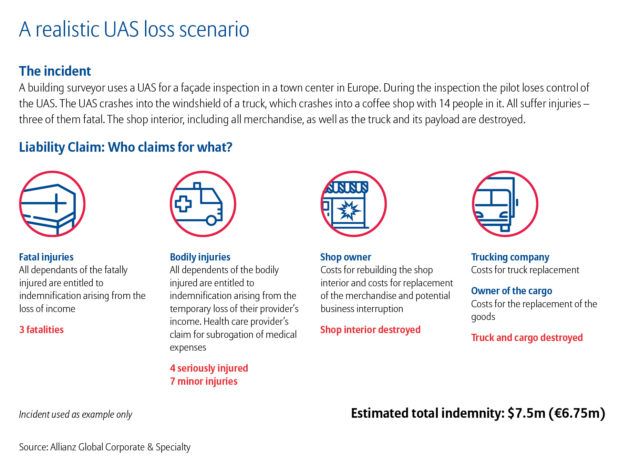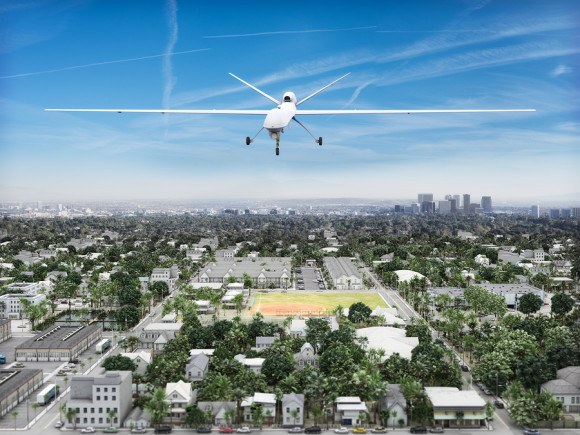The fledgling drone insurance market could be worth more than $500 million in the U.S. by the end of 2020 and $1 billion globally, assuming growth projections for the technology’s commercial use materialize, according to a report from Allianz Global Corporate & Specialty.
“Globally,” [drone] market volume is forecast to reach 4.7 million units by 2020 … with the market for commercial application of [drone] technology estimated to soar from $2 billion to $127 billion,” ACGS said. “Such projections are driven by [drones] becoming cheaper, smaller and easier to use, as well as regulatory progress.”
The thing is, the rapid increase of drones will create a traffic jam, of sorts, in the U.S. and around the world. With that will come a slew of new risks, according to AGCS.
“Advances in technology are inevitably accompanied by a host of new and little understood risks,” the report states. “There have already been enough incidents and near misses to date involving [drones] to generate concern that the likelihood of collisions and other loss events will grow.”
Here is a sense of how crowded drone traffic is likely to become. By the end of 2016 alone, there will be more than 600,000 drones – also known as unmanned aircraft systems (UAS) – deployed for commercial use. That’s three times the amount of manned general aviation aircraft, according to Federal Aviation Administration statistics cited by AGCS. On top of that, expectations are that there will be 1.9 million drones in play for recreational use, with drone numbers expected to triple by 2020.
 Of concern here, in part, is that drones are generally used recreationally and they continue to be unregulated in many countries. That, in part, stems from the reality that drone users in this context are often untrained.
Of concern here, in part, is that drones are generally used recreationally and they continue to be unregulated in many countries. That, in part, stems from the reality that drone users in this context are often untrained.
AGCS said that a surge in drone use raises concern about the risk of “multi-million-dollar claims against businesses, operators and manufacturers” should something go wrong. A sky crowded with drones also raises worry over the risk of mid-air collisions and the loss of control, according to the report, particularly with helicopters, agriculture planes and other manned aircraft flying below 500 feet (drone flying ranges). That would also include aircraft landing at or leaving from airports.
To be sure, drones offer plenty of benefits. AGCS outlines some of them in its report, including the fact that they can perform “basic or dangerous tasks.”
Insurers including AIG, USAA, State Farm and Munich Re’s Hartford Steam Boiler have gotten into the drone game themselves, winning Federal Aviation Administration exemptions to start testing drones for property inspections, underwriting and loss prevention work.
To help counter these risks, AGCS calls for “systemic registration of drones, robust education and training of operators necessary to ensure safe skies.”
In August, first-time regulations governing civilian drone operations in the U.S. took effect, allowing anyone 16 or older to fly for hire if they pass a background check and written knowledge test. On Aug. 29, the first day those regulations kicked in, more than, 3,300 signed up to take the test.
The full AGCS report is called: “Rise of the Drones: Managing the Unique Risks Associated with Unmanned Aircraft Systems.”
Source: Allianz Global Corporate & Specialty





















 Berkshire Hathaway Enters Post-Buffett Era as Share Prices Fall
Berkshire Hathaway Enters Post-Buffett Era as Share Prices Fall  Northern California Flooding This Weekend Caused by Heavy Rain, High Tides
Northern California Flooding This Weekend Caused by Heavy Rain, High Tides  Underwriter, Actuary Fears of AI Drop; Work Needed on Collaboration
Underwriter, Actuary Fears of AI Drop; Work Needed on Collaboration  Artificial Intelligence Is Rewriting the Rules for Commercial Lines
Artificial Intelligence Is Rewriting the Rules for Commercial Lines 







